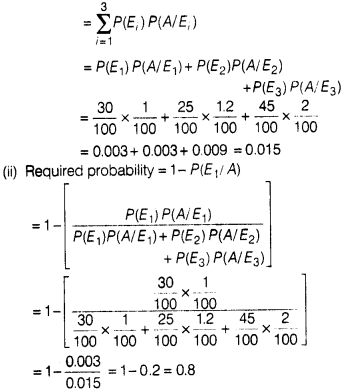CBSE Sample Papers for Class 12 Maths Set-7
Class 12thCBSE Sample Papers for Class 12 Maths Set-7
CBSE Sample Papers for Class 12 Maths Set 7 with Solutions
Time Allowed: 3 Hours
Maximum Marks: 80
General Instructions:
- This question paper contains – five sections A, B, C, D and E. Each section is compulsory. However, there are internal choices in some questions.
- Section A has 18 MCQ’s and 02 Assertion-Reason based questions of 1 mark each.
- Section B has 5 Very Short Answer (VSA) type questions of 2 marks each.
- Section C has 6 Short Answer (SA) type questions of 3 marks each.
- Section D has 4 Long Answer (LA) type questions of 5 marks each.
- Section E has 3 source based/case/passage based/intergrated units of assessment (4 marks each) with sub-parts.
Section
A
(Multiple Choice Questions)
Each question carries 1 mark
Question 1.
The cartesian equation of the line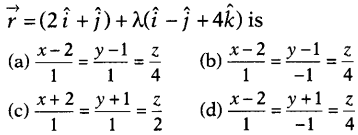
Solution:
(b) Given, vector equation of line is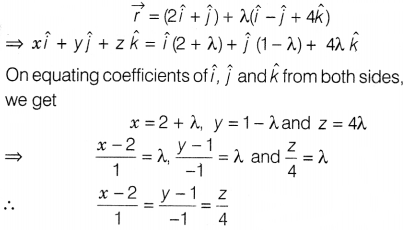
Which is the required cartesian equation of line.
Question 2.
If P(A) = \(\frac{1}{2}\) and P(B) = 0, then
P(\(\frac{A}{B}\)) is equal to
(a) 1
(b) 0
(c) not defined
(d)
0.5
Solution:
(c) It is given that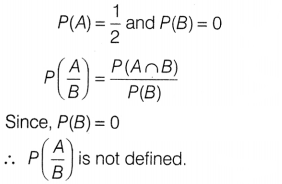
Question 3.
If A and B are two independent events, then P( A ∩
\(\overline{\mathrm{B}}\)) is equal to
Solution:
(a) We have, P(A ∩ \(\overline{\mathrm{B}}\)) =
P(A) – P(\(\overline{\mathrm{B}}\))
[∵ A and 6 are independent events]
⇒
P(A ∩ \(\overline{\mathrm{B}}\)) = P(A) . [1 – P(B)] = P(A) – P(A) . P(B)
Question 4.
\(\int_0^\pi\frac{xdx}{1+sinx}\)
(a) π
(b) 2π
(c)
3π
(d) π/2
Solution: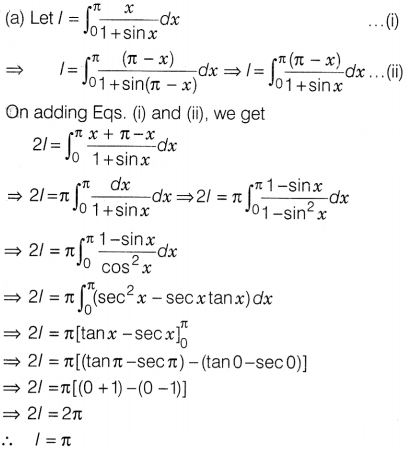
Question 5.
If I be any interval disjoint from [-1, 1], then the function
f given by f(x) = x + \(\frac{1}{x}\) is
(a) strictly decreasing on I
(b)
strictly increasing on I
(c) decreasing on I
(d) Only (a) and (c) are
true
Solution:
(b) Given, f(x) = x + \(\frac{1}{x}\) ⇒ f'(x) = 1 –
\(\frac{1}{x^2}=\frac{x^2+1}{x^2}\)
[on differentiating w.r.t. x we get]
If x< -1, then f'(x) > 0. If x > 1, then f'(x) > 0
∴ f(x) is
strictly increasing on interval / disjoint from [-1, 1]
Question 6.
Direction cosines of the vector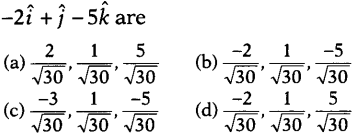
Solution: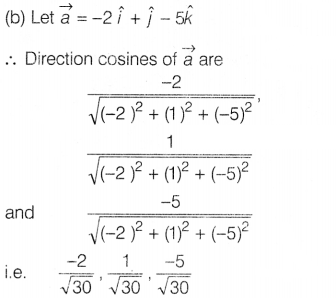
Question 7.
The least value of a, such the function f given by f(x) = x² +
ax + 1 is strictly increasing on (1, 2) is
(a) -1
(b) -2
(c) 0
(d)
1
Solution:
(b) We find f'(x), then for 1 < x < 2, put f'(x) > 0
and find the required least value of a.
Given, f(x) = x² + ax + 1 ⇒ f'(x) =
2x + a
In interval (1, 2), 1 < x < 2 ⇒ 2 < 2x < 4
⇒ (2 + a)
< (2x + a) < (4 + a) Since, f(x) is strictly increasing function, then (2
+ a) > 0 [for this f'(x) > 0 and (2x + a) > (2 + a)]
∴ (2 + a) >
0
⇒ a > -2
Hence, the least value of a = – 2.
Question 8.
If
\((\hat{i}+3\hat{j}+9\hat{k})\times(3\hat{i}-\lambda\hat{j}+\mu\hat{k})\) = 0,
then λ + µ is equal to
(a) 10
(b) 18
(c) 0
(d) 1
Solution: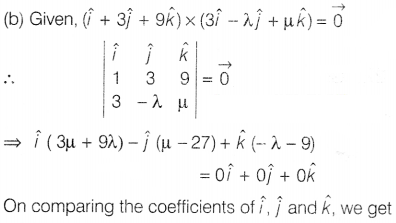
3µ + 9λ = 0, – µ + 27 = 0 and -λ – 9 = 0
⇒ µ = 27 and λ =
-9
Also, the values of µ and λ satisfy the equation 3µ + 9λ = 0.
∴ λ + µ =
-9 + 27 = 18
Question 9.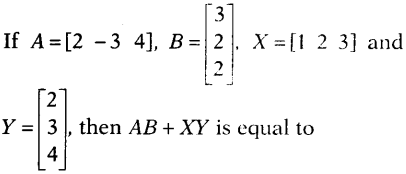
(a) [28]
(b) [24]
(c) 28
(d) 24
Solution: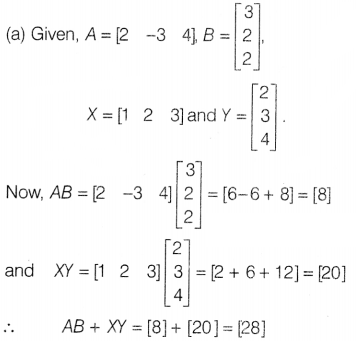
Question 10.
A bag contains 5 red and 3 blue balls. If 3 balls are drawn
at random without replacement, then the probability of getting exactly one red
ball is
(a) \(\frac{15}{36}\)
(b) \(\frac{15}{46}\)
(c)
\(\frac{15}{56}\)
(d) \(\frac{1}{2}\)
Solution:
(c) We have, 5 red and
3 blue balls.
Probability of getting exactly one red ball, when 3 balls are
drawn is
Question 11.
\((\hat{k}\times\hat{j}).\hat{i}+\hat{j}.\hat{k}\) is equal
to
(a) -1
(b) 1
(c) 0
(d) -2
Solution:
Question 12.
\(\int_0^{\pi}\)|sin x| dx is equal to
(a) 1
(b)2
(c) 3
(d) 4
Solution: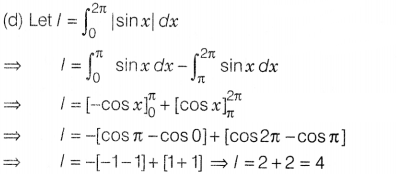
Question 13.
If y = Ae5x + Be-5x, then
\(\frac{d^2y}{dx^2}\) is equal to
(a) 25y
(b) 5y
(c) -25y
(d)
15y
Solution: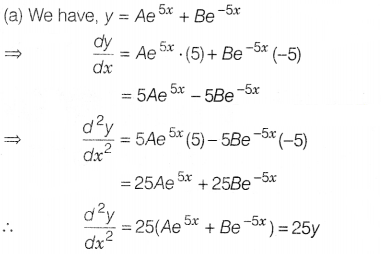
Question 14.
to
(a) 1
(b) 2
(c) -3
(d) -5
Solution:
⇒ x + y = 2 and x – y = 4
Since (x + y)² – (x – y)² =
4xy
∴ 2² – 4² = 4xy
⇒ 4xy = 4 – 16 = -12 ⇒ xy = -3
Question 15.
Let A and B be the events associated with the sample space S,
then the value of P(A/B) lies in the interval
(a) (0, 1)
(b) [0, 1]
(c)
(0, 1]
(d) [0, 1)
Solution:
(b) 0 ≤ P(A/B) ≤ 1
Question 16.
Write the number of vectors of unit length perpendicular to
both the vectors
\(\vec{a}=2\hat{i}+\hat{j}+2\hat{k}\) and
\(\vec{b}=\hat{j}+\hat{k}\)
(a) 1
(b) 2
(c) 3
(d) 4
Solution:
(b) We know that unit vectors perpendicular to \(\vec{a}\) and
So, there are two unit vectors perpendicular to the given
vectors.
Question 17.
Area of the region bounded by the curve y² = 4V, F-axis and
the line y = 3 is
(a) 2 sq units
(b) \(\frac{9}{4}\) sq units
(c)
\(\frac{9}{3}\) sq units
(d) \(\frac{9}{2}\) sq units
Solution:
(b) The
area bounded by the curve y² = 4x. Y-axis and y = 3 is represented in the figure
by shaded region.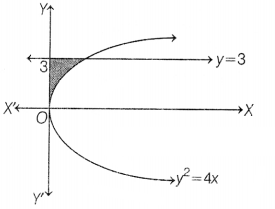
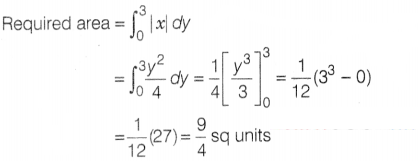
Question 18.
A unit vector in the direction of vector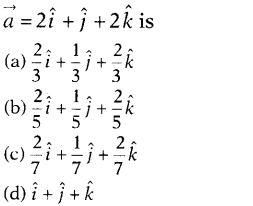
Solution:
(a) We know that unit vector in the direction of
\(\vec{a}\) is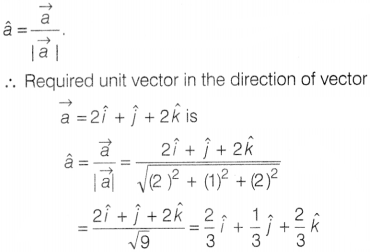
Assertion-Reason Based Questions
In the following questions, a statement
of Assertion (A) is followed by a statement of Reason (R). Choose the correct
answer out of the following choices.
(a) Both A and R are true and R is the
correct explanation of A
(b) Both A and R are true but R is not the correct
explanation of A
(c) A is true but R is false
(d) A is false but R is
true.
Question 19.
Assertion (A) Scalar matrix
an identity matrix when k = 1.
Reason (R) Every identity
matrix is not a scalar matrix.
Solution:
matrix, when k =1.
But every identity matrix is clearly a
scalar matrix as identity matrix is a diagonal matrix in which all the diagonal
elements are equal.
Hence, Assertion is true but Reason is false.
Question 20.
Assertion (A) The relation R on the set N × N defined by (a,
b)R(c, d) ⇔ a + d = b + c, for all (a, b), (c, d) ∈ N × N is an equivalence
relation.
Reason (R) Any relation is an equivalence relation, if it is
reflexive, symmetric and transitive.
Solution:
(a) Let (a, b) be an
arbitrary element of N × N.
Then, (a, b) ∈ N × N
⇒ a, b ∈ N
⇒ a + b = b
+ a [by commutative of addition in N]
⇒ (a, b)R(a, b)
⇒ R is reflexive on
N × N.
Let (a, b), (c, d) ∈ N × N be such that (a, b) R(c, d).
⇒ a + d = b
+ c
⇒ b + c = a + d
⇒ c + b = d + a
⇒ (c, d)R(a, b)
⇒ R is symmetric
on N × N.
Now, let (a, b), (c, d), (e, f) ∈ N × N, such that (a, b)R(c,d) and
(c, d)R(e, f).
∵ (a, b)R(c,d)
⇒ a + d= to + c …(i)
∵ (c, d)R(e, f)
⇒
c + f = d + e …(ii)
On adding Eqs. (i) and (ii), we get (a + d) + (c + f) =
(b + c) + (d + e)
⇒ a + f = b + e
⇒ (a, b)R(e, f)
Thus, (a, b) R(c, d)
and (c, d) R(e, f).
⇒ (a, b)R(e, f)for all (a, b),(c, d), (e, f) ∈ N × N
⇒
R is transitive on N × N.
⇒ R is an equivalence relation on N × N
Section
B
(This section comprises of very
short answer type questions (VSA) of 2 marks each)
Question 21.
If AB = BA for any two square matrices, then prove by
mathematical induction that (AB)n = AnBn.
Or
Solution:
Let P(n): (AB)n = AnBn
∴
P(1) : (AB)¹ = A¹B¹ ⇒ AB = AB
So, P(1) is true.
Now, P(k):
(AB)k = AkBk, k ∈ N
So, P(k) is true,
whenever P(k +1) is true.
∴ P(AB)k+1 =
Ak+1Bk+1
⇒ AkBk.BA =
AkBk+1 ⇒ Ak . A . Bk+1 =
Ak+1Bk+1
⇒ (A.B)k+1 =
Ak+1Bk+1
So, P(k + 1)is true for all n ∈ N, whenever
P(/r)is true. By mathematical induction, (AB) = AnBn
is
true for all a ∈ N. Hence proved.
Or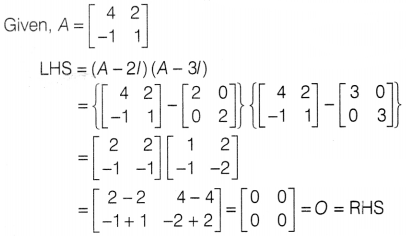
Hence proved.
Question 22.
Find the position vector of a point R which divides the line
joining the points
P\((\hat{i}+2\hat{j}-\hat{k})\)
andQ\((-\hat{i}+\hat{j}+\hat{k})\) in the ratio 2 : 1
(i) internally.
(ii)
externally.
Solution: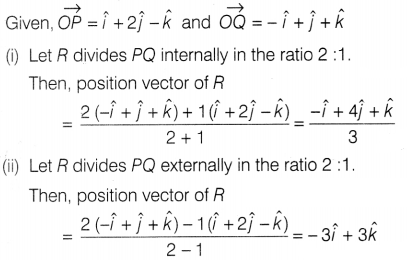
Question 23.
Show that the points (a + 5, a – 4), (a – 2, a + 3) and (a,
a) do not lie on a straight line for any value of a.
Or
II (a, b), (a’,
b’) and (a – a’, b – b’) are collinear, then prove that ab’ = a’b.
Solution:
Given points are (a + 5, a – 4), (a -2, a + 3) and (a, a).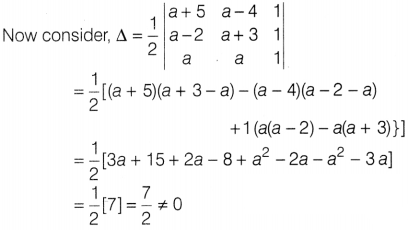
which is also independent of a.
Hence, the given points
form a triangle i.e. given points do not lie on a straight line for any value of
a.
Hence proved.
Or
If given points are collinear, then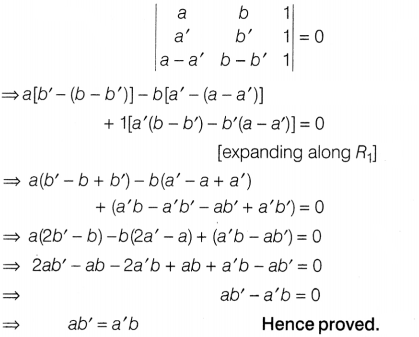
Question 24.
Find the general solution of the differential equation
\(\frac{dy}{dx}\) = ex +y.
Solution:
The given differential
equation is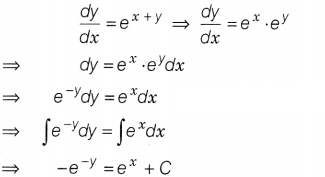
which is the required solution.
Question 25.
The x-coordinate of a point on the line joining the points
P(2, 2, 1) and Q(5, 1, -2) is 4. Find its z-coordinate.
Solution:
The
equation of line joining the points
P(2, 2, 1) and Q(5, 1, -2) is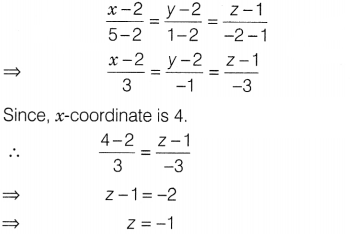
Section
C
This section comprises of short
answer type questions (SA) of 3 marks each
Question 26.
Find the inverse of the matrix
Solution: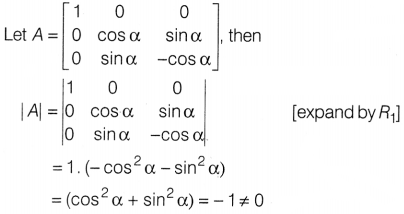
⇒ A-1 exists.
To find adj A,
A11
= -1, A12 = 0, A13 = 0; A21 = 0, A22
= -cos α, A23 = -sin α.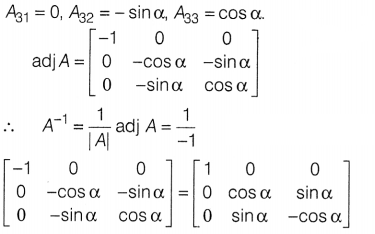
Question 27.
Using integration, find the area of the region bounded by the
curves y = |x + 1| + 1, x = -3, A = 3 and y = 0.
Solution:
Given curves
are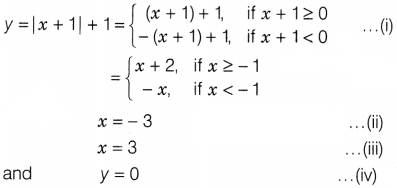
Eq. (ii) represents the line parallel to V-axis and passes
through the point (- 3, 0).
Eq. (iii) represents the line parallel to Y-axis
and passes through the point (3, 0).
Eq. (iv) represents X-axis.
Now, Eqs.
(i), (ii), (iii) and (iv) can be represented in graph as shown below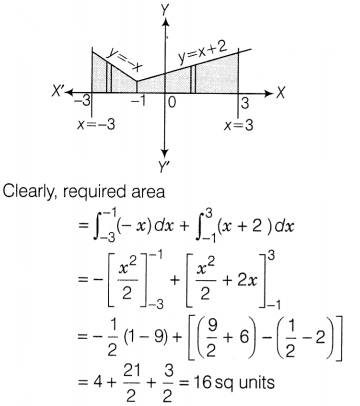
Hence, the required area is 16 sq units.
Question 28.
If the sum of two unit vectors \(\hat{a}\) and \(\hat{b}\) is
a unit vector, then show that the magnitude of their difference is √3.
Or
If |\(\vec{a}\)| = 10, |\(\vec{b}\)| = 2 and \(\vec{a}.\vec{b}\) = 12, then find
the value of |\(\vec{a}\times\vec{b}\)|.
Solution:
Let
\(\vec{c}=\hat{a}+\hat{b}\) = a + b. Then, according to given condition c is a
unit vector i. e.|\(\vec{c}\)| = 1 …(i)
To show |\(\hat{a}-\hat{b}\)| =
√3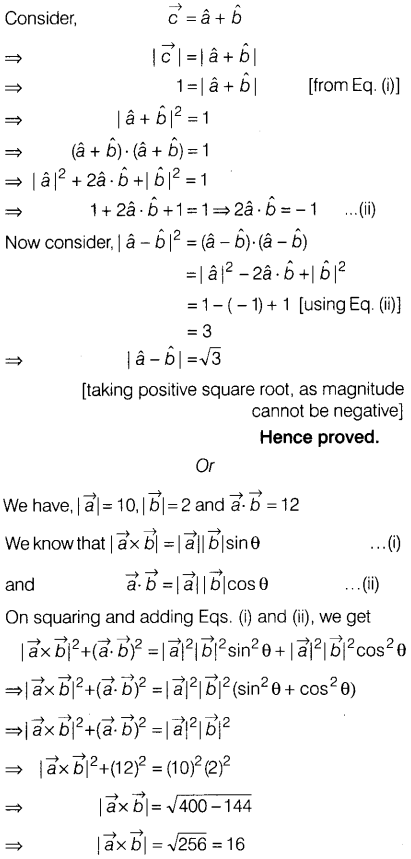
Question 29.
Find ∫\(\frac{x^2+x+1}{(x+1)^2(x+2)}\)dx.
Or
Evaluate
∫\(\frac{sin(x-\alpha)}{sin(x+\alpha)}\)dx
Solution: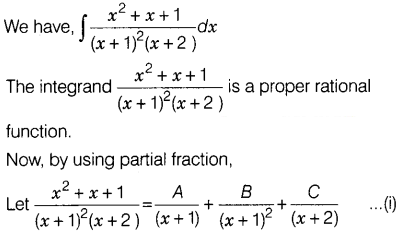
⇒ x² + x + 1 = A(x + 1)(x + 2) + B (x + 2) + C(x + 1)²
⇒
x² + x + 1 = A(x² + 3x + 2) + B(x + 2 ) + C(x² + 2x + 1)
⇒ x² + x + 1 = (A +
C)x² + (3A + B + 2C)x + (2A + 2B + C)
On comparing the coefficients of like
powers from both sides, we get
A + C = 1
3A + B + 2C = 1 and 2A + 2B + C =
1
On solving these equations, we get
A = -2, B = 1 and C = 3
From
Eq.(i), we get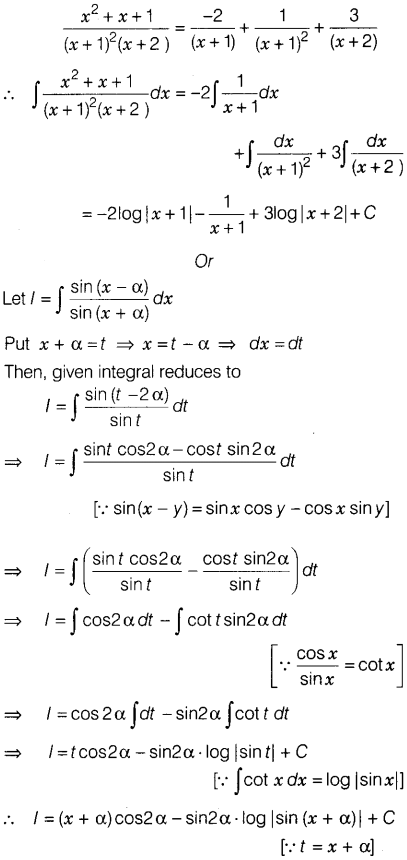
Question 30.
Find the value of
Solution: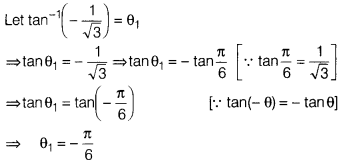
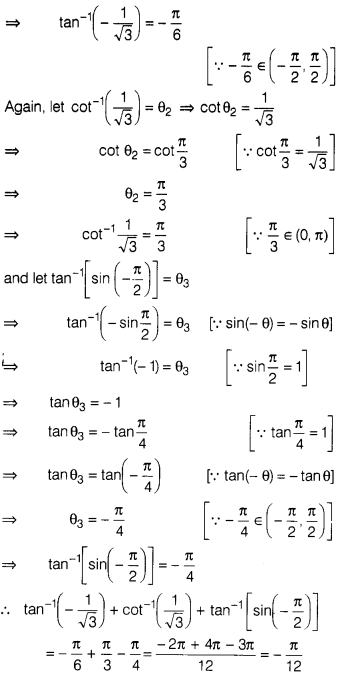
Question 31.
Find the value of a, for which the function
continuous at x = 0.
Or
If x = a(2t – sint) and y = a(1
– cost), then find \(\frac{dy}{dx}\) when θ = \(\frac{\pi}{6}\)
Solution: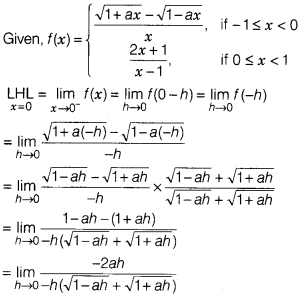
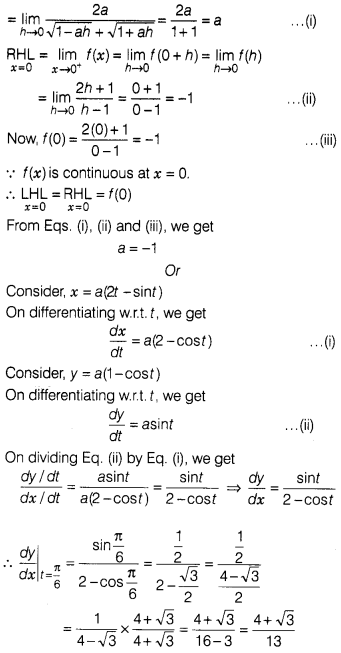
Section
D
(This section comprises of long
answer type questions (LA) of 5 marks each)
Question 32.
Solve the following differential equation
Solution:
Given differential equation is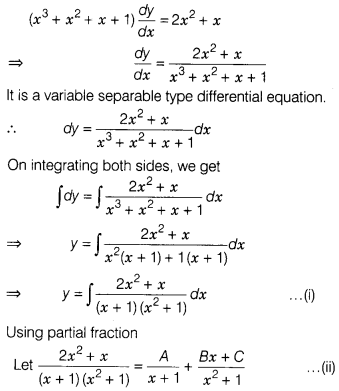
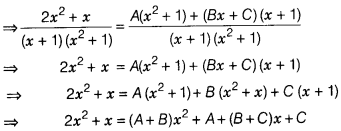
On comparing the coefficients of x², x and constant terms
from both sides, we get
A + B = 2, B + C = 1
and A + C = 0 ⇒ A = -C
On
solving above equations, we get
A = \(\frac{1}{2}\), B = \(\frac{3}{2}\) and
C = – \(\frac{1}{2}\)
On substituting the values of A, B and C in Eq. (ii),
we get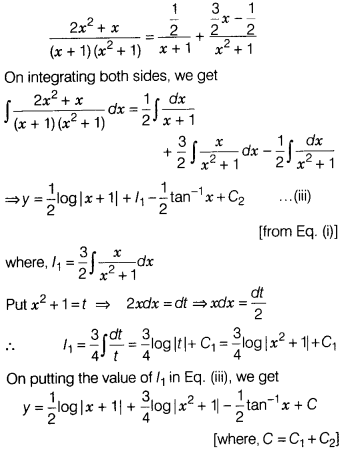
which is the required solution.
Question 33.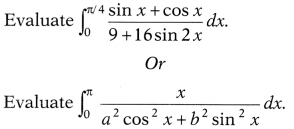
Solution: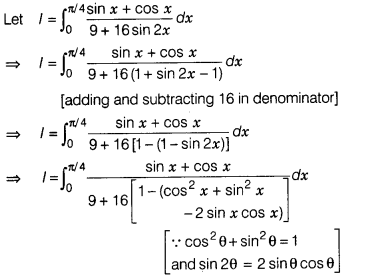
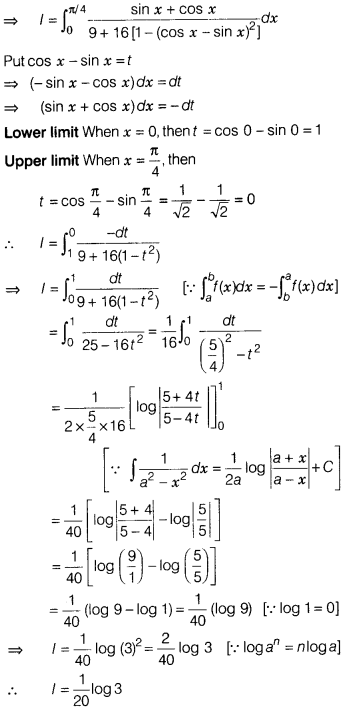
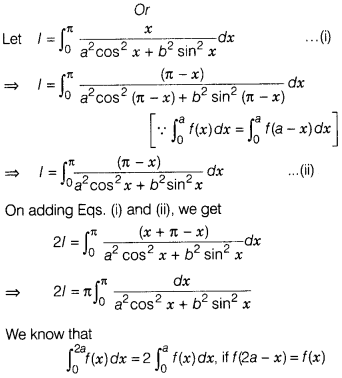
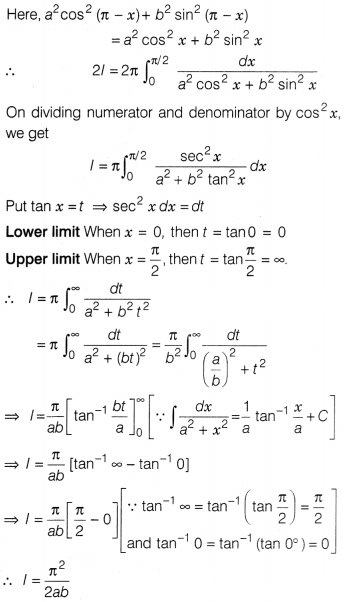
Question 34.
Determine graphically the minimum value of the objective
function
Z = – 50x + 20y, subject to constraints are
2x – y ≥ – 5, 3x + y
≥ 3, 2 x – 3y ≤ 12 and x ≥ 0, y ≥ 0.
Or
Find graphically, the maximum
value of Z = 2x + 5y, subject to constraints given below
2 x + 4y ≤ 8, 3x + y
≤ 6,
x + y ≤ 4, x > 0, y≥0.
Solution:
Given objective function
is
Minimise Z = – 50x + 20y
Subject to constraints, 2x – y ≥ – 5
…..(i)
3x + y ≥ 3 …..(ii)
2x – 3y ≤ 12 …..(iii)
and x ≥ 0, y ≥ 0
…..(iv)
Table for line 2x – y = -5 is
| x | -5/2 | 0 |
| y | 0 | 5 |
So, the line passes through the points (\(\frac{-5}{2}\), 0) and (0, 5).
On putting (0, 0) in the inequality 2x – y ≥ -5, we get
0 – 0 ≥ -5
⇒ 0 ≥
-5, which is true.
So, the half plane is towards the origin.
Table for
line 3x + y = 3 is
| x | 0 | 1 |
| y | 3 | 0 |
So, the line passes through the points (0, 3)and(1, 0). On putting (0, 0) in
the inequality 3x + y ≥ 3, we get
0 + 0 ≥ 3
⇒ 0 ≥ 3, which is not
true.
So, the half plane is away from the origin.
Table for line 2x – 3y =
12 is
| x | 0 | 6 |
| y | -4 | 0 |
So, the line passes through the points (0, -4) and (6, 0).
On putting (0,
0)in the inequality 2x – 3y ≤ 12, we get
0 – 0 ≤ 12
⇒ 0 ≤ 12, which is
true.
So, the half plane is towards the origin.
Also, x ≥ 0 and y ≥ 0, so
the region lies in the 1st quadrant.
On drawing the graph of each linear
equation, we get the following graph. In first quadrant, these equations has no
intersection point.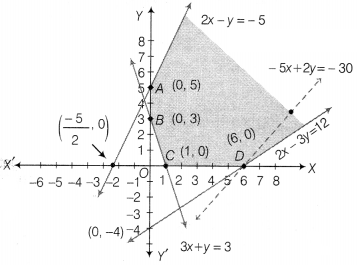
which gives the feasible region and it is unbounded. The corner points of
feasible region are A(0, 5), B(0, 3), C(1, 0)and D(6, 0).
The value of Z at
corner points are given below
| Corner points | Z = -50x + 20y |
| A(0, 5) | Z = – 50(0)+ 20(5) = 100 |
| B(0, 3) | Z = – 50(0) + 20(3) = 60 |
| C(1, 0) | Z = – 50(1) + 20(0) = – 50 |
| D( 6, 0) | Z = – 50(6) + 20(0) = – 300 |
Here, feasible region is unbounded so the minimum and maximum value may or
may not exist.
Now, we draw a dotted line of inequation
– 50x + 20y <
-300 or – 5x + 2y < -30
Here, we see that half plane determined by – 5x + 2y < – 30 has a point in
common with the feasible region.
Hence, no minimum value exists.
Or
We
have the following LPR,
Maximise, Z = 2x + 5y
Subject to constraints,
2x + 4y < 8 or x + 2y ≤ 4
3x + y ≤ 6
x + y ≤ 4
and x ≥ 0, y ≥ 0
Now, considering the inequations as equations, we
get x + 2y = 4 …(i)
3x +
y = 6 …(ii)
and x + y = 4 …(iii)
Table for line x + 2y = 4 is
| x | 4 | 0 |
| y | 0 | 2 |
So, the line passes through (4, 0) and (0, 2).
On putting (0, 0) in the
inequality x + 2y ≤ 4, we get
0 + 0 ≤ 4 [which is true]
So, the half plane
is towards the origin.
Table for line 3x + y = 6 is
| x | 2 | 0 |
| y | 0 | 6 |
So, the line passes through (2, 0) and (0, 6).
On putting (0, 0) in the
inequality 3x + y ≤ 6, we get
0 + 0 ≤ 6 [which is true]
So, the half plane
is towards the origin.
Table for line x + y = 4 is
| x | 4 | 0 |
| y | 0 | 4 |
On putting (0, 0) in the inequality x + y ≤ 4, we get
0 + 0 ≤ 4 [which is
true]
So, the half plane is towards the origin.
Also, x ≥ 0, y ≥ 0 , so
the region lies in the 1st quadrant.
The graphical representation of the
above system of inequations is given below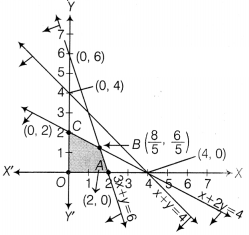
Clearly, the feasible region is OABCO.
The intersection
point of lines (i) and (ii) is B(\(\frac{8}{5}\), \(\frac{6}{5}\))
Thus, the
corner points are
O(0, 0), A(2, 0), B(\(\frac{8}{5}\), \(\frac{6}{5}\)), C(0,
2).
The values of Z at corner points are as follows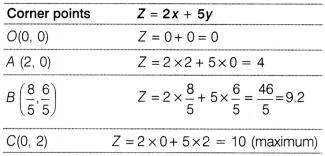
Hence, the maximum value of Z is 10.
Question 35.
If y = (log x)x + xlog x, then find
\(\frac{dy}{dx}\).
Solution:
We have, y = (logx)x+ xlog
x
Let u = (log x)x and v = xlog x
Then, y = u
+ v
⇒ \(\frac{dy}{dx}=\frac{du}{dx}+\frac{dy}{dv}\) …….(i)
Consider, u =
(logx)x
On taking log both sides, we get
log u =
log(logx)x = xlog(log x)
On differentiating both sides w.r.t. x,
we get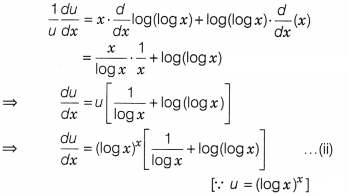
Now, v = xlog x
On taking log both sides, we get
log v =
log(xlog x)
= (log x) (log x)
= (log x)²
On differentiating
both sides w.r.t. x, we get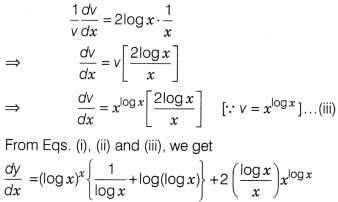
Section
E
This section comprises of 3
case-study/passage-based questions of 4 marks each
Question 36.
If a real valued function f(x) is finitely derivable at any
point of its domain, it is necessarily continuous at that point. But its
converse need not be true.
e.g. Every polynomial, constant functions are both
continuous as well as differentiable and inverse trigonometric functions are
continuous and ‘ differentiable in their domain etc.
Based on the above
information, answer the following questions,
(i) Write the interval in which
the function f(x) = cos-1 x is always continuous.
(iii) Show that the function f(x) = |x – 2|, x ∈ R, is
continuous at x = 2.
Or Show that the function f(x) = |cos 2x| is continuous
at x = \(\frac{\pi}{4}\)
Solution:
(i) cos-1 x is always
continuous in its domain, x ∈ [-1, 1].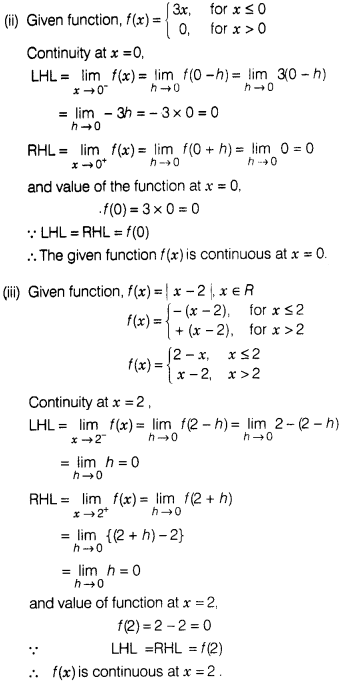
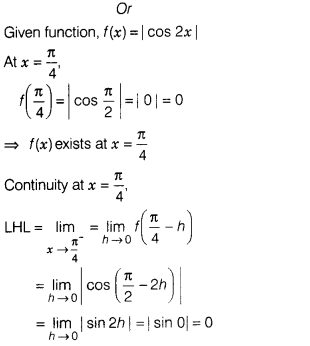
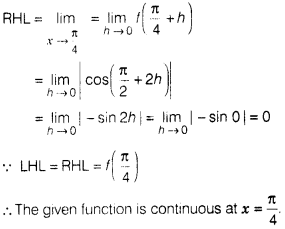
Question 37.
In a classroom, a teacher teaches a topic ‘Relation on a
set’, which is defined below.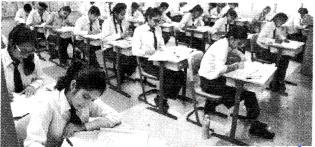
A relation Ron a set A is said to be an equivalence relation
on A iff it is
I. Reflexive i.e. aRa or (a, a) ∈ R,∀ a ∈ A.
II. Symmetric
i.e. aRb ⇒ bRa
or(a, b) ∈ R ⇒ (b, a) ∈ R, where a,b ∈ A.
III. Transitive
i.e. if aRb and bRc, then aRc
or (a, b) ∈ R and (b, c) ∈ R
⇒ (a, c) ∈ R,
where a, b, c ∈ A.
Based on the above information, answer the following
questions.
(i) If the relation R = {(1, 1), (1, 2), (1, 3), (2, 2), (2, 3),
(3, 1), (3, 2), (3, 3)} defined on the set A = {1, 2, 3}, then show that R is
reflexive but neither symmetric nor transitive.
(ii) If the relation R = {(1,
2), (2, 1), (1, 3), (3, 1)} defined on the set A = {1, 2, 3}, then show that R
is symmetric but neither reflexive nor transitive.
(iii) If the relation R on
the set N of all natural numbers defined as R = {(x, y): y – x + 5 and x <
4}, then show that R is neither reflexive, nor symmetric nor transitive.
Or
The relation R in the set Z of integers given by R = {(a, b): 2 divides (a
– b)}, show that R is an equivalence relation.
Solution:
(i) ∵ (1, 1), (2,
2), (3, 3) ∈ R
⇒ R is reflexive on A.
Now, (1, 2) efl but (2, 1) ∈ R
⇒
R is not symmetric on A.
Now, (2, 3) eRand (3, 1) eRbut (2, 1) ∈ R
⇒ R is
not transitive on A.
(ii) ∵ j(d, .1) (2, 2) and (3, 3) are not in R.
⇒ R is not reflexive on
A.
∵ (1, 2) ∈ R ⇒ (2, 1) eR and (1, 3) ∈ R.
⇒ (3, 1) ∈ R fl is
symmetric.
∵ (1, 2) ∈ R and (2, 1) ∈ R but (1, 1) ∉ R
∴ R is not
transitive on A.
(iii) Given, R={(x, y):y = x + 5 and x < 4}, where x, y ∈ N
R = {(
1,6), (2, 7), (3, 8)}
∵ (1, 1), (2, 2) and (3, 3) are not in R.
So, R is
not reflexive.
Now, (1, 6) ∈ R but (6, 1) ∉ R
⇒ R is not symmetric.
Now, (1, 6) ∈ R and there is no order pair in R which has 6 as the first
element.
Similar is the case for (2, 7) and (3, 8).
⇒ R is not
transitive.
Or
Given, R={(a,b) : 2 divides(a – d)}
and Z = Set of
integers
Reflexive Let aeZ be any arbitrary element.
Now, if (a, a) ∈ R,
then 2 divides a-a, which is true.
So, R is reflexive.
Symmetric Let a.b ∈
Z, such that (a, b) ∈ R.
2 divides (a – b).
⇒ 2 divides [-(a – b)]
⇒ 2
divides (b – a) ⇒ (b, a) ∈ R
So, R is symmetric.
Transitive Let a,b,c ∈ Z,
such that (a, b) ∈ R and (b.c) ∈ R.
⇒ a – b and b – c both are divisible by
2.
⇒ a-b + to -c is divisible by 2.
⇒ (a – c) is divisible by 2 ⇒ (a, c) ∈
R
So, R is transitive.
Thus, R is reflexive, symmetric and transitive.
Hence, R is an equivalence relation.
Question 38.
In a school, teacher asks a question to three students Ravi,
Mohit and Sonia.
The probability of solving the question by Ravi, Mohit and
Sonia are 30%, 25% and 45%, respectively. The probability of making error by
Ravi, Mohit and Sonia are 1%, 1.2% and 2%, respectively.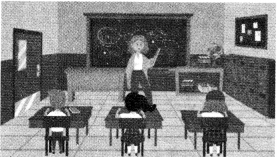
Based on the above information, answer the following
questions.
(i) Find the total probability of committing an error in solving
the question.
(ii) If the solution of question is checked by teacher and has
some error, then find the probability that the question is not solved by
Ravi.
Solution:
Let
A = The event that question has some error
E1 = The event that question is solved by Ravi
E2 = The
event that question is solved by Mohit
E3 = The event that
question is solved by Sonia
Then, we have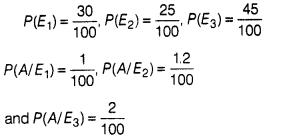
(i) Required probability = P(A)